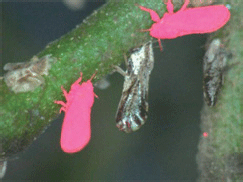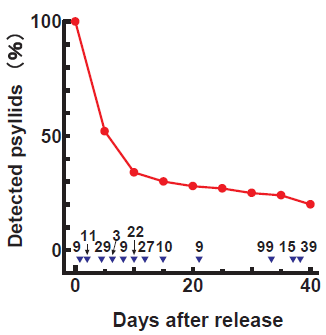Effective marking method using fluorescent powder for dispersal study of the citrus psyllid, Diaphorina citri
Description
Asian citrus greening disease (CGD) is caused by Candidatus Liberibacter asiaticus, transmitted by the Asian citrus psyllid, Diaphorina citri Kuwayama. No effective method of controlling this pathogen is currently available, so controlling the vector psyllids is more practical. However, lack of effective marking methods limits ecological/ethological field studies on this insect. We evaluated the effectiveness of a marking method for psyllids using fluorescent powder.
We examined the persistence of a pinkish fluorescent powder on the bodies of psyllids and its effects on their survival, fecundity, and flight activity in the laboratory. After confirming its effectiveness as a marking agent, its usefulness in the field was examined.
Equal numbers of marked and non-marked psyllids (Fig. 1) were released two meters in front of a light. The number of collected marked psyllids near the light was significantly lower than that of non-marked psyllids until four hours after the release. After five hours, no significant difference was observed. No significant differences were detected between the two groups, either in mortality over 40 days or in number of eggs laid on orange jasmine, Murraya exotica L., for five days after marking. The marking on the psyllid body was confirmed visually in the laboratory to remain for 40 days. One hundred marked psyllids were released in an orange jasmine field (18 m x 18 m). During the experiment, total precipitation was 289 mm. These conditions were difficult for the psyllids and we suspected that the powder would wash off. However, the marked insects were visually identifiable. The proportion was 30% after 20 days and 20% after 40 days (Fig. 2).
These results indicate that our marking method using fluorescent powder does not affect the mortality or fecundity of psyllids, and that it can be used for approximately six weeks in the field. Thus, the dust marking method can be used for the detection of psyllids for 40 days, even in the rainy season, and for longer durations in the dry season. This method will thus contribute to the promotion of ecological and ethological field studies of the psyllids.
Figure, table
-
Fig. 1. Marked and non-marked psyllids on orange jasmine. -
Fig. 2. Proportion of detected psyllids after release.
Proportion of marked psyllids released (100 at the beginning) in the field, and later detected visually on orange jasmine from February 18, 2005 to March 30, 2005.
Inverted triangles ( ▼ ) and numerals placed above them indicate the occurrence of rainfall and the precipitation (mm), respectively.
- Affiliation
-
Japan International Research Center for Agricultural Sciences Okinawa Subtropical Station
- Term of research
-
FY2004(FY2002~2008)
- Responsible researcher
-
NAKATA Tadafumi ( Okinawa Subtropical Station )
- ほか
- Publication, etc.
-
NAKATA, T. (2005) Abstract of 49th annual meeting of the Japanese Society of Applied Entomology & Zoology (in press)
- Japanese PDF
-
2004_19_A3_ja.pdf661.53 KB


